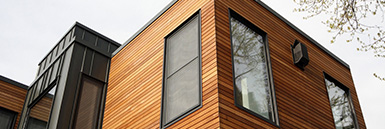There are lots of different reasons why energy efficiency and thermal performance will define the direction of travel for the window and door industry.
Today it’s about retail, the immediate opportunity to pitch energy-efficient products to end-users who have seen their energy bills rocket in the 12 months since April last year.
It’s also, however, about regulation and where government targets will take us tomorrow. Part L changes last year, which introduced the new 1.2w/m2k for new build and 1.4w/m2k, for home improvement, were the prelude.
Government climate change obligations are driving new targets for home energy efficiency. Part L changes in June last year need to be seen in this context, and as a stepping-stone to even greater change in 2025, when a further tightening of regulation is expected in the form of the Future Homes Standard.
“It’s about energy efficiency and it’s about flush. They’re the two biggest drivers of the market.
As a new aluminium system we aren’t trying to squeeze more out of older systems. We’ve brought a systems offer to market that is designed to deliver performance – not adapted to meet it.
That’s an important distinction.”
Nigel Headford, Director, Deceuninck Aluminium
This is reflected in the design of what will become Deceuninck’s new systems offer in only a few weeks’ time.
Next-generation energy efficiency
Still unnamed, the new Decalu flush aluminium casement system achieves headline u-values of 0.8w/m2k. This is in a triple-glazed configuration.
It’s what the system achieves double-glazed that will resonate most strongly with fabricators as Nigel explains. “Our new flush casement achieves a U-value of 1.2w/m2k with a double-glazed unit with a centre pane u-value of 1.0w/m2k” he says.
“That’s a 1.2w/m2k u-value – Part L newbuild compliance double-glazed – from an aluminium flush casement window.
“With a ‘standard unit with a centre pane u-value of 1.2w/m2k it’s 1.4w/m2k – Part L home improvement.
“That’s a big and tangible commercial advantage to Decalu fabricators and installers”, he argues.
Iteration49; UK designed
The working title for this project – Iteration 49 – reflects the 49 different ‘iterations’ that the UK design team has gone through, to get the design to where it is today, something also reflected in the detail of the design.
The starting point for this next-generation level of performance is the patented thermal break used in the system.
Deceuninck Aluminium has opted for an ABS rather than a PVC system. This has allowed it to create more complex and effective thermal chambers but also to co-extrude a more flexible hinged chamber.
This houses the Eurogroove and can be opened to fix into the substrate and then closed to hide fixings. Alternatively, it can also be cut to house hardware, creating a clean minimalist finish.
Flush both sides
In addition to concealed fixing, hardware and drainage, its new window also features a flush finish internally, as well as externally and a pre-inserted flush-to-the-bead gasket.
It also delivers maximum design flexibility, accommodating weights of up to 180kg and units ranging from 12-52mm.
Suitable for mechanical or crimp jointing, the system is modular, sharing the common knock-in glazing bead used throughout the system lowering stock holding.
It’s also supplied marine-grade and in metallic and dual colour finishes as standard.
“We have applied a lot of time and effort on getting the performance, mechanics and engineering of this window right”, explains Nigel.
“We know, however, installers have got to sell it. We wanted simple minimalist sightlines, when the window is closed with the flush finish internally as well as externally, and even when the window is open through concealed hardware and fixings.”
The new window forms the final piece in a systems’ offer which already includes the popular Decalu88 Bifold, the Decalu163 Lift-and-Slide, a pre-existing range including tilt-and-turn and steel-type options, and even a curtain walling system.
“You’ve got to remember we only launched Decalu in 2019”, Nigel says, “so we’ve come a long way very quickly.
“What we’re very proud about is that the new flush casement has been designed here in the UK and exclusively for the UK market.
“It means we’ve taken care of current regulation – in a double-glazed aluminium system – and have built-in bandwidth for future regulation and the changes that are coming down the line in only two years’ time in the Future Homes standard.
“Our customers don’t have to be looking over their shoulder at what’s coming down the line tomorrow and can take advantage of tangible manufacturing efficiencies today.”

